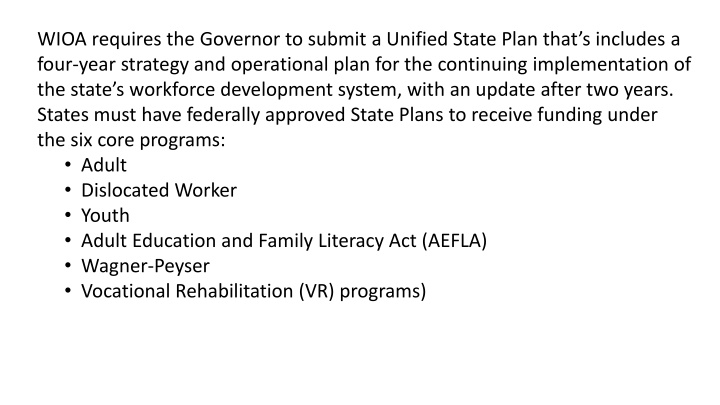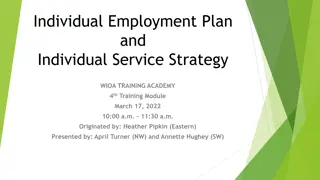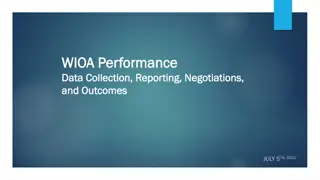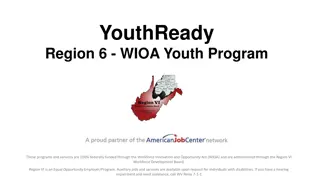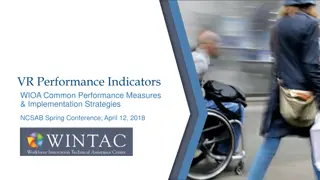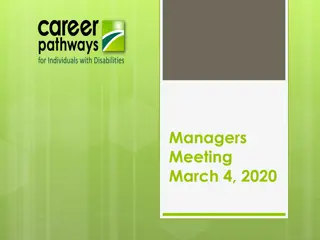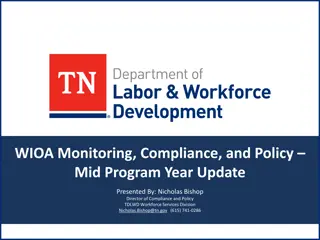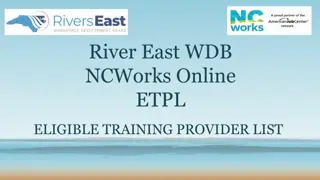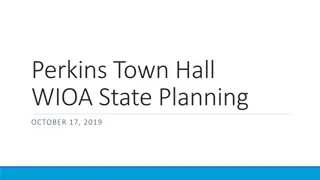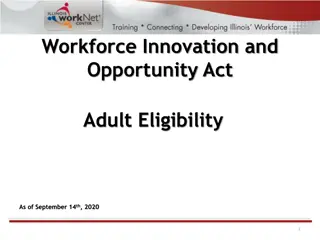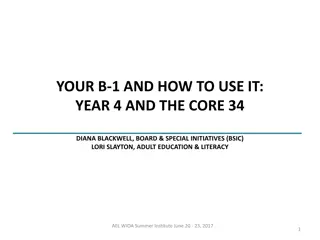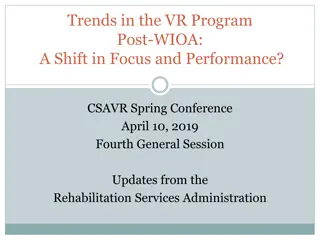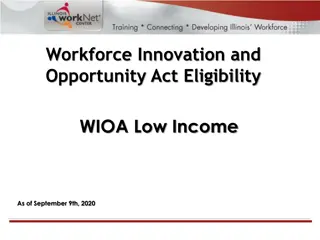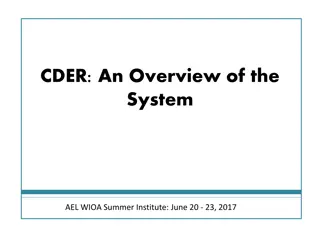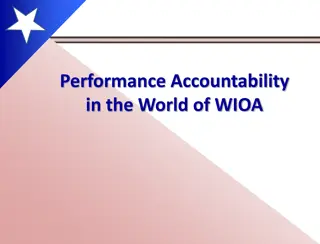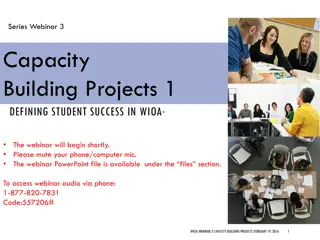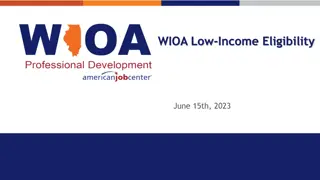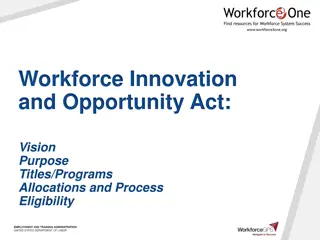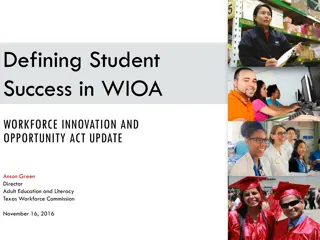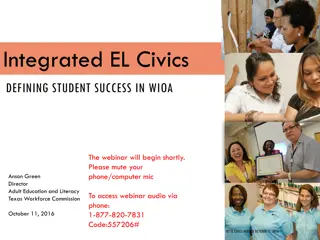WIOA State Plan Implementation and Updates
WIOA requires the submission of a Unified State Plan with a four-year strategy for workforce development, updated every two years based on economic changes. State Plans ensure alignment of federal investments in job training and education programs to match skilled individuals with job opportunities.
Download Presentation

Please find below an Image/Link to download the presentation.
The content on the website is provided AS IS for your information and personal use only. It may not be sold, licensed, or shared on other websites without obtaining consent from the author.If you encounter any issues during the download, it is possible that the publisher has removed the file from their server.
You are allowed to download the files provided on this website for personal or commercial use, subject to the condition that they are used lawfully. All files are the property of their respective owners.
The content on the website is provided AS IS for your information and personal use only. It may not be sold, licensed, or shared on other websites without obtaining consent from the author.
E N D
Presentation Transcript
WIOA requires the Governor to submit a Unified State Plan thats includes a four-year strategy and operational plan for the continuing implementation of the state s workforce development system, with an update after two years. States must have federally approved State Plans to receive funding under the six core programs: Adult Dislocated Worker Youth Adult Education and Family Literacy Act (AEFLA) Wagner-Peyser Vocational Rehabilitation (VR) programs)
All states currently have approved WIOA State Plans. However, WIOA requires that states review their plan every two years and update State Plan strategies, based on: changes in the labor market and economic conditions reorganization of state administering agencies of WIOA programs redesignation of local areas establishment of new planning regions changes to funding allocations other significant strategic or operational changes within the state
Under WIOA, the Unified State Plans communicate the states vision for the state workforce system WIOA planning requirements aim to foster better alignment of federal investments across job training and education programs in order to align service delivery across programs among shared customers Improve efficiency in service delivery, and to ensure that the workforce system matches skilled individuals with high-quality job opportunities and employers. Cross-program planning promotes a shared understanding of the workforce needs The development of more comprehensive and aligned approaches, such as career pathways and sector strategies, for addressing the needs of workers, especially those with barriers to employment, including individuals with disabilities, and businesses. Enables the workforce system to provide a wider range of coordinated and streamlined services to shared customers.
WIOA Planning Priorities 1. Data-driven decisions When the WIOA State plan was submitted the COVID-19 pandemic disrupted the plan significantly As a result, it is particularly critical, for purposes of developing and submitting the State Plan modification Reassessment of economic and labor market information (LMI) Adjust strategies for what may now be a different set of growing and declining industries, occupations, and skills Understand the current and growing needs of the economy Adapt and adjust workforce goals and strategic focus for those communities with higher unemployment rates and lower earnings particularly among underserved population groups, or individuals facing barriers to employment (e.g., low-income individuals, English language learners, individuals without housing, individuals with disabilities)
2. Reemployment WIOA emphasizes integrating services to better serve workforce customers All workforce system partners have a shared responsibility to facilitate the reemployment of unemployed individuals and the improved employment of underemployed individuals. Encourage states to examine how well their systems and operations across the WIOA one-stop partner programs, including Unemployment Insurance (UI), can work more seamlessly together to positively affect the shared goal of reemployment, particularly for individuals with barriers to employment, including individuals with disabilities.
3. Equity in service delivery and educational programming Examine which population groups, particularly those identified in the LMI analysis as having higher unemployment and lower earnings than the overall population, experience inequities in access to and participation in public workforce programs that lead to quality jobs. Develop education, training, and career service strategies that better address and promote equity in recruitment, service design, implementation, and support services that aim to provide equitable access and outcomes to all communities seeking access to state services. Transitions and alignment among programs, including programs that support low-income jobseekers such as recipients of Temporary Assistance for Needy Families (TANF), Supplemental Nutrition Assistance Program (SNAP), and those supporting individuals with disabilities such as state Mental Health or Medicaid services, promote economic stability. Leverage pandemic related investment, from both the public and private sector, to build and improve capacity of educational programming. Supporting educators to leverage technology for innovative and personalized instruction and increasing access to internet and devices for students and families.
4. Enhance supportive service offerings Services that assist individuals to begin to return to work not only include education, training, and employment services, but also include services that support individuals personal and family needs to address barriers to work. Supportive services are essential to ensure that youth and adults can stay engaged in program offerings and reach their educational and employment goals Partnerships with community-based organizations
Stakeholder Collaboration and Comment. Stakeholder collaboration, review, and comment are key requirements of the four-year planning process, as well as the two-year modification. State Workforce Development Boards (State Boards) are responsible for assisting the Governor in the development, implementation, and modification of the plan and for convening all relevant programs, required partners, and stakeholders to contribute to the State Plan The State Plan must be developed with the assistance of the State Board, as required by Section 101(d) of WIOA, and in coordination with administrators that have optimal policymaking authority for the core programs and required one-stop partner programs.
A meeting is scheduled for June 24, 2022. Representatives from Workforce Development Vocational Rehabilitation Adult Education and Family Literacy Act At this meeting, each partner will be sharing the revisions/modifications. Each partner will present this information at the next WDC Board Meeting. The WDC Board members input is extremely valuable. The modification is for two years.
